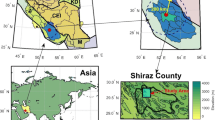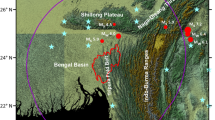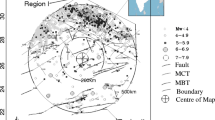Abstract
A seismic hazard map for the national seismic design code of Pakistan (i.e., Building Code of Pakistan) is derived using probabilistic seismic hazard assessment (PSHA) approach. In order to update the seismic code, an updated seismic zoning map is required that should be based on usage of the recent seismic hazard elements. PSHA of Pakistan is an essential and important milestone. For this purpose, the standard Cornell–McGuire (1968–1976) approach is employed, and the computations are made over a rectangular grid of 0.1°. The main features of this study include usage of a recently compiled earthquake catalogue, recent ground motion prediction equations and an updated seismic source model. The resulting ground motions are obtained as peak ground acceleration (PGA) and 5% damped spectral acceleration (SA) at T = 0.2 s and T = 1.0 s for 475-, 975- and 2475-year return periods (RPs) (evaluated for the flat rock site conditions). Results of the study show that seismic hazard in Pakistan is highest in its central and northern parts. In the central part near Quetta, severe seismic hazard (PGA 0.40 g) is observed. Among the important cities in Pakistan, Balakot city is likely to experience a PGA value of 0.36 g, while Islamabad, Peshawar and Chitral are likely to experience 0.33 g. The cities of Gilgit, Karachi and Gwadar experience ground motion values of 0.34, 0.26 and 0.29 g, respectively, for the 475-year return period (RP). It has also been observed that ground motion values show variation in the distribution and magnitude in contrast to the hazard map of national design code. The hazard map presented in this study is the improved seismic hazard zoning map of Pakistan that would be helpful in developing pre-disaster mitigation strategies and risk assessment studies in Pakistan. It is concluded that the seismic zoning map of the national seismic design code of Pakistan underestimates the ground motion values, and it should be updated or replaced.













Similar content being viewed by others
References
AASHTO-LRFD. (2012). Bridge design specifications. Washington, D.C.: American Association of State Highway and Transportation Officials.
Ader, et al. (2012). Convergence rate across the Nepal Himalaya and interseismic coupling on the Main Himalayan Thrust: Implications for seismic hazard. Journal Of Geophysical Research, 117, 1–16.
Akkar, S., & Bommer, J. J. (2010). Empirical equation for prediction of PGA, PGV, and spectral acceleration in Europe, the Mediterranean region, and the Middle East. Seismological Research Letters, 8(2), 195–206.
Akkar, S., Sandıkkaya, M. A., & Bommer, J. J. (2014). Empirical ground-motion models for point-and extended-source crustal earthquake scenarios in Europe and the Middle East. Bulletin of Earthquake Engineering, 12, 359–387.
Ambraseys, N. (2000). Reappraisal of north-Indian earthquakes at the turn of the 20th century. Current Science (special edition), 79(09), 1237–1250.
Ambraseys, N., & Bilham, R. (2003). Earthquakes in Afghanistan. Seismological Research Letters, 74, 107–123.
Ambraseys, N., & Bilham, R. (2009), The tectonic setting of Bamiyan and seismicity in and near Afghanistan for the past twelve centuries. In Margottini C (ed) UNESCO special publication: The destruction of the Giant Buddha statues in Bamiyan, Central Afghanistan, UNESCO’s emergency activities for the recovering and rehabilitation of cliff and niches, vol. 158, pp. 67–94 (ISBN 978-448-0375-5).
Ambraseys, N., & Douglas, J. J. (2004). Magnitude calibration of north Indian earthquakes. Geophysical Journal International, 159, 165–206.
Apel, E., Burgmann, R., & Nagarajan, B. (2006). Geodetically constrained Indian plate motion and implications for plate boundary deformation. Eos, Transactions, American Geophysical Union 85, 52 T51B-1524 Fall meeting supplement.
Baig, M. S., & Lawrence, R. D. (1987). Precambrian to early Paleozoic orogenesis in the Himalaya. Kashmir Journal of Geology, 5, 1–22.
Bilham, R. (1999). Slip parameters for the Rann of Kachchh, India, 16 June 1819, earthquake, quantified from contemporary accounts. In I. S. Stewart & C. Vita-Finzi (Eds.), Coastal tectonics (Vol. 146, pp. 295–318). London: Geological Society.
Bilham, R., & Ambraseys, N. (2005). Apparent Himalayan slip deficit from the summation of seismic moments for Himalayan earthquakes, 1500–2000. Current Science, 88(10), 1658–1663.
Bilham, R., Lodhi, S., Hough, S., Bukhary, S., Khan, M. A., & Rafeeqi, S. F. A. (2007). Seismic hazard in Karachi, Pakistan: Uncertain past, uncertain future. Seismological Research Letters, 78(6), 601–613.
Bommer, J. J., Douglas, J., Scherbaum, F., Cotton, F., Bungum, H., Faeh, D., et al. (2010). On the selection of ground-motion prediction equations for seismic hazard analysis. Seismological Research Letters, 81, 783–793.
Boore, M. D., Stewart, P. J., Jonathan, P., Seyhan, E., & Gail, M. A. (2014). NGA-West2 equations for predicting PGA, PGV, and 5% damped PSA for shallow crustal earthquakes. Earthquake Spectra, 30(3), 1057–1085.
Building Code of Pakistan: Seismic Provisions (2007) Ministry of Housing and Society, Government of Pakistan.
Cornell, C. A. (1968). Engineering seismic risk analysis. Bulletin of Seismological Society of America, 58(05), 1583–1606.
Cotton, F., Scherbaum, F., Bommer, J. J., & Begum, H. (2006). Criteria for selecting and adjusting ground-motion models for adjusting for specific target regions: Applications to central Europe and rock sites. Journal of Seismology, 10, 137.
Desio, A. (1963). Review of the geologic “formations” of the western Karakorum (central Asia). Rivista Italiana di Paleontologia e Stratigrafia, 69, 475–501.
EZ-FRISK software for earthquake ground motion estimation, version 7.62. Risk Engineering, Inc, USA.
Frankel, A. (1995). Mapping seismic hazard in the central and eastern United States. Seismological Research Letters, 66(4), 8–21.
Fukushima, Y., & Tanaka, T. (1990). A new attenuation relation for peak horizontal acceleration of strong earthquake ground motion in Japan. Bulletin of Seismological Society of America, 80, 757–783.
Gansser, A. (1981). The geodynamic history of the Himalaya. In H. K. Gupta & F. M. Delany (Eds.), Zagros, Hindu Kush, Himalaya: Geodynamic evolution (pp. 111–121). Washington: AGU.
Gardner, J. K., & Knopoff, L. (1974). Is the sequence of earthquakes in Southern California, with aftershocks removed, Poissonian? Bulletin of Seismological Society of America, 64(5), 1363–1367.
Gulan, L., & EMME WP 2 Team. (2014). Earthquake Model of the Middle East (EMME) project. Active faults and seismic sources, Second European conference on Earthquake Engineering and Seismology, Istanbul, August 25–29.
Gutenberg, B., & Richter, C. F. (1956). Earthquake magnitude, intensity, energy, and acceleration (second paper). Bulletin of Seismological Society of America, 46(2), 105–145.
Heidarzadeh, M., Pirooz, M. D., Zaker, N. H., Yalciner, A. C., Mokhtari, M., & Esmaeily, A. (2008). Historical tsunami in the Makran Subduction Zone off the southern coasts of Iran and Pakistan and results of numerical modeling. Ocean Engineering, 35, 774–786.
IBC. (2015). International Building Code, International Code Council (ICC), ICC 700.
Joyner, W. B., & Boore, D. M. (1981). Peak horizontal acceleration and velocity from strong-motion records including records from the 1979 Imperial Valley, California, earthquake. Bulletin of Seismological Society of America, 71(6), 2011–2038.
Kanno, T., Akria, N., Morikawa, N., Fujiwara, H., & Fukushima, Y. (2006). A new attenuation for strong ground motion in Japan based on recorded data. Bulletin of Seismological Society of America, 96(3), 879–897.
Khan, S., Waseem, M., Khan, M. A., & Ahmed, W. (2018). Updated earthquake catalogue for seismic hazard analysis for Pakistan. Journal of Seismology. https://doi.org/10.1007/s10950-018-9736-y.
Kramer, S. L. (1996). Geotechnical earthquake engineering. New Jersey: Prentice-Hall.
Lawrence, R. D., Khan, S. H., & Nakata, T. (1992). Chaman fault, Pakistan–Afghanistan. In R. C. Bucknam, P. L. Hancock (Eds.) Major active faults of the world—Results of IGCP project 206: Annnales Tectonicae, Supplement to v6, 196–223.
Martin, S., & Szeliga, W. (2010). A catalog of felt intensity data for 570 earthquakes in India from 1636 to 2009. Bulletin of Seismological Society of America, 100, 562–569.
McGuire, R. K. (1976). FORTRAN computer program for seismic risk analysis (pp. 76–6768). Open file Report: United States Geological Survey.
Mukhopadhyay, B., & Dasgupta, S. (2015). Seismic hazard assessment of Kashmir and Kangra valley region, Western Himalaya, India. Geomatics, Natural Hazards and Risk, 6(2), 149–183.
Mulargia, F., & Tinti, S. (1985). Completeness analysis of a seismic catalogue. Annals Geophysics, 3(3), 407–414.
Nath, S. K., & Thingbaijam, K. K. S. (2012). Probabilistic seismic hazard assessment of India. Seismological Society of America, 83(1), 135–149.
Oldham, T. (1883). A catalogue of Indian earthquakes from the earliest times to the end of 1869 A.D. Memoirs of the Geological Survey of India, 19(3), 163–215.
Quittmeyer, R., & Jacob, K. (1979). Historical and modern seismicity of Pakistan, Afghanistan, northwestern India, and south eastern Iran. Bulletin of Seismological Society of America, 69(3), 773–823.
Rafi, Z., Lindholm, C., Bungum, H., Laghari, A., & Ahmed, N. (2012). Probabilistic seismic hazard map of Pakistan, Azad Jammu and Kashmir. Natural Hazards, 61(3), 1317–1354.
Rahman, M. M., & Bai, L. (2018). Probabilistic seismic hazard assessment of Nepal using multiple source models. Earth and Planetary Physics, 2, 327–341.
Rahman, M. M., Bai, L., Khan, N. G., & Li, G. (2017). Probabilistic seismic hazard assessment of Himalayan–Tibetan region from historical and instrumental earthquake catalogs. Pure and Applied Geophysics, 175, 685–705.
Sawires, R., Pelaez, J. A., Fat-Hebary, R. E. F., & Ibrahim, A. A. (2016). Updated probabilistic seismic hazard values for Egypt. Bulletin of Seismological Society of America, 106(04), 1788–1801.
Sesetyan, K., Demircioglu, B. M., Duman, Y. T., Can, T., Tekin, S., Azak, E. T., et al. (2018a). A probabilistic seismic hazard assessment of the Turkish territory—part I: the area source model. Bulletin of Earthquake Engineering, 16(1), 3367–3397.
Sesetyan, et al. (2018b). The 2014 seismic hazard model of Middle East: Overview and results. Bulletin of Earthquake Engineering, 16(08), 3535–3566.
Shah, M. A., Iqbal, T., Qaiser, M., Ahmed, N., & Tufail, M. (2012). Development of attenuation relationship for northern Pakistan. In The 15th world conference on earthquake engineering, Lisbon, Portugal.
Shedlock, K. M., Giardini, D., Grunthal, G., & Zhang, P. (2000). The GSHAP global seismic hazard map. Seismological Research Letters, 71(6), 679–686.
Stepp, J. C. (1973). Analysis of completeness of earthquake sample in the Punget Sound area in seismic zoning. In Harding, S. T. (Ed.) NOAA Technical Report ERL 267-ESL 30, Boulder, Colorado.
Stevens, V. L., & Avouac, J. P. (2015). Interseismic coupling on the main Himalayan thrust. Geophysical Research Letters, 20, 5828–5837.
Styron, R., Taylor, M., & Okoronkwo, K. (2010). HimaTibetMap-1.0: New ‘web-2.0’ online database of active structures from the Indo-Asian collision. Eos, 91, 20. https://github.com/HimaTibetMap/HimaTibetMap.
Taylor, M., & Yin, A. (2009). Active structures of the Himalayan–Tibetan orogen and their relationships to earthquake distribution, contemporary strain field, and Cenozoic volcanism. Geosphere, 05(03), 199–214. https://github.com/HimaTibetMap/HimaTibetMap.
Uniform Building Code (UBC). (1997). ICBO international conference of building officials, structural engineering design provisions (Vol. 2). Whittier: Uniform Building Code.
Waseem, M., Khan, M. A., & Sarfraz, K. (2019). Seismic sources for Pakistan and seismic hazard analysis of Karachi. Natural Hazards, 99(1), 511–536.
Waseem, M., Lai, G. C., & Spacone, E. (2018a). Seismic hazard assessment of northern Pakistan. Natural Hazards, 90(2), 563–600.
Waseem, M., Lateef, A., Ahmad, I., et al. (2018b). Seismic hazard assessment of Afghanistan. Journal of Seismology. https://doi.org/10.1007/s10950-018-9802-5.
Wells, D. L., & Coppersmith, K. J. (1994). New empirical relationships among magnitude, rupture length, rupture width, rupture area, and surface displacement. Bulletin of the Seismological Society of America, 84(4), 974–1002.
Wiemer, S. (2001). A software package to analyze seismicity: ZMAP. Seismological Research Letters, 72, 373–382.
Woo, G. (1996). Kernel estimation methods for seismic hazard area source modelling. Bulletin of the Seismological Society of America, 88, 353–362.
Youngs, R. R., Chiou, S. J., Silva, W. J., & Humphrey, J. R. (1997). Strong ground motion attenuation relationships for subduction zone earthquakes. Seismological Research Letters, 68(1), 58–73.
Zaman, S., Ornthammarath, T., & Warnitchai, P. (2012). Probabilistic seismic hazard maps for Pakistan. In The 15th world conference on earthquake engineering, Lisbon, Portugal.
Zhang, P., Yang, Z., Gupta, K. H., Bhatia, C. S., & Shedlock, M. K. (1999). Global seismic hazard assessment program (GSHAP) in continental Asia. Annali di Geofisica, 42(06), 1167–1190.
Zhao, X. J., Zhang, et al. (2006). Attenuation relations for strong ground motion in Japan using site classification based on predominant period. Bulletin of Seismological Society of America, 3, 898–913.
Acknowledgements
The authors acknowledge facilities and the financial support in the purchase of the EZ-FRISK software provided by the National Centre of Excellence in Geology, University of Peshawar, Pakistan, and the EZ-FRISK software, version 7.62, developed for earthquake ground motion prediction. Additionally, the comments and recommendations of the editor and of the anonymous reviewers of the paper are gratefully acknowledged for their constructive review, improving the quality of the article. The various online earthquake data agencies from which data was collected for the earthquake catalogue are acknowledged, including the International Seismological Centre (ISC), National Earthquake Information Center (NEIC), National Geophysical Data Center (NGDC), World Data Centre (WDCse), India Meteorological Department (IMD), Pakistan Meteorological Department (PMD), Micro Seismic Studies Program (MSSP), seismic stations of Mangla and Tarbela dams and the Water and Power Development Authority (WAPDA).
Author information
Authors and Affiliations
Corresponding author
Additional information
Publisher's Note
Springer Nature remains neutral with regard to jurisdictional claims in published maps and institutional affiliations.
Electronic supplementary material
Below is the link to the electronic supplementary material.
Rights and permissions
About this article
Cite this article
Waseem, M., Khan, S. & Asif Khan, M. Probabilistic Seismic Hazard Assessment of Pakistan Territory Using an Areal Source Model. Pure Appl. Geophys. 177, 3577–3597 (2020). https://doi.org/10.1007/s00024-020-02455-7
Received:
Revised:
Accepted:
Published:
Issue Date:
DOI: https://doi.org/10.1007/s00024-020-02455-7




